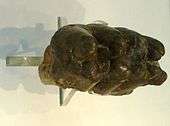Tetralophodon
| Tetralophodon Temporal range: Miocene–Middle Pleistocene | |
|---|---|
| | |
| Fossil skull and tusks of T. longirostris, from Ballestar, Spain at the Museu Geològic del Seminari de Barcelona, Barcelona | |
| Scientific classification | |
| Kingdom: | Animalia |
| Phylum: | Chordata |
| Clade: | Synapsida |
| Class: | Mammalia |
| Order: | Proboscidea |
| Family: | †Gomphotheriidae |
| Genus: | †Tetralophodon |
| Species | |
| |
Tetralophodon ("four-ridged tooth") is an extinct gomphothere genus belonging to the family Gomphotheriidae.[1][2][3]
Etymology
The genus Tetralophodon (meaning "four-ridged tooth") was named in the mid-19th century with the discovery of the specialized teeth.
Description
Tetralophodon was an elephant-like animal which existed through the late Miocene to the Middle Pleistocene epochs,[4] approximately 10.9 million years.
Like typical gomphotheres, mastodons with four tusks, Tetralophodon had four tusks and a trunk. In fact, also this animal had two further tusks protruding from the jaw. The overall appearance recalled Gomphotherium, the best known genus of the family Gomphotheriidae.
Their body is believed to be about 2.58–3.45 m (8.5–11.3 ft) tall at the shoulder and up to 10 tonnes in weight,[5] larger than the size of the present Asian elephant, with the long trunk and incisors ranging up to 2 m (6.6 ft) long. These incisors are believed to be utilized as a defense mechanism
The large, four-cusped cheek teeth of these animals are approximately 60 mm (2.4 in) by 80 mm (3.1 in), about 6 times the size of a normal human tooth. These low-crowned, bunodont teeth are designed for crushing and grinding, compared with other mammals during this era that had sharp teeth used for cutting. The teeth of the tetralophodon indicate a diet of large fruits and vegetables. This diet is aided by the large size and long trunks of the elephantiods that enable these mammals to reach tall, fruit-bearing trees.
Some features, mainly concerning the teeth, would seem to place Tetralophodon close to the origin of today's elephants. The molars, in particular, are more advanced and specialized than those of the other gomphotheres.
Distribution

These animals were very widespread and successful proboscideans. Their fossils have been found from the late Miocene to the Middle Pleistocene epochs of Europe, Asia, and Africa. Most fossil records of tetralophodon are of four-ridged teeth. The North American species, T. campester and T. fricki, have been moved to the genus Pediolophodon in 2007.[2]
The majority of the gomphotheres became extinct at the end of the Pleistocene. While the reason for this extinction is still debated, what is known is that these massive elephantoids under the genus Tetralophodon did not survive.[2]
See also
References
- ↑ Ugan, A.; Byers, D. (2007). "Geographic and temporal trends in proboscidean and human radiocarbon histories during the late Pleistocene". Quaternary Science Reviews. 26 (25–28): 3058. Bibcode:2007QSRv...26.3058U. doi:10.1016/j.quascirev.2007.06.024.
- 1 2 3 Lambert, W. D. (2007). "New tetralophodont gomphothere material from Nebraska and its implications for the status of North AmericanTetralophodon". Journal of Vertebrate Paleontology. 27 (3): 676–673. doi:10.1671/0272-4634(2007)27[676:NTGMFN]2.0.CO;2.
- ↑ "The Paleobiology Database:Tetralophodon". Retrieved 2012-03-07.
- ↑ "ON THE SUBDIVISIONS AND EVOLUTION OF THE QUATERNARY MAMMALIAN FAUNAS OF SOUTH CHINA--《Certebrata Palasiatica》1981年01期". en.cnki.com.cn. Retrieved 2016-06-12.
- ↑ Larramendi, A. (2016). "Shoulder height, body mass and shape of proboscideans" (PDF). Acta Palaeontologica Polonica. 61. doi:10.4202/app.00136.2014.